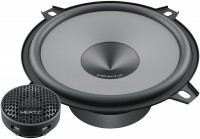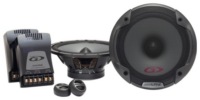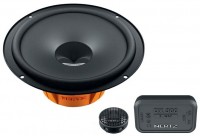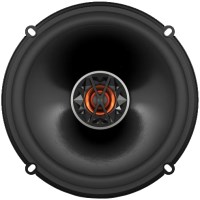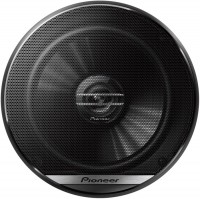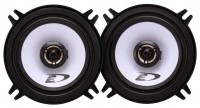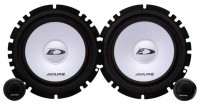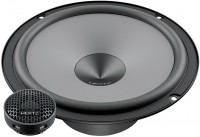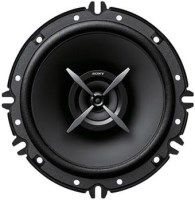Car Speakers JBL
All Car Speakers Advanced filters → |
You might be interested in
Car Speakers: specifications, types
Application area
— Automotive. Classic speaker systems designed for use in cars. Characteristics and functionality can vary greatly from model to model, but the common thing is that they are all designed primarily for interiors that are not exposed to bad weather and do not have special protection against adverse effects (for example, splashes).
— Navigation. Acoustic systems designed primarily for installation in water vehicles (boats and yachts). Such models have increased protection of the hull (at least protection against moisture), usually they can be installed in open cabins without fear of splashing. Technically, most models can be installed in a car, but this does not always make sense, because. a protected case usually significantly affects the price, and it pays off only in some cases (for example, on SUVs on extreme expeditions).
— Mototechnics. Acoustics designed for motorcycles, ATVs and other similar vehicles. Such an application is associated with two points: firstly, there is not much space for additional equipment in motor vehicles, and secondly, this equipment works, in fact, in the open. Accordingly, the key features of motoacoustics are small size and an increased level of dust and water protection.
— Navigation. Acoustic systems designed primarily for installation in water vehicles (boats and yachts). Such models have increased protection of the hull (at least protection against moisture), usually they can be installed in open cabins without fear of splashing. Technically, most models can be installed in a car, but this does not always make sense, because. a protected case usually significantly affects the price, and it pays off only in some cases (for example, on SUVs on extreme expeditions).
— Mototechnics. Acoustics designed for motorcycles, ATVs and other similar vehicles. Such an application is associated with two points: firstly, there is not much space for additional equipment in motor vehicles, and secondly, this equipment works, in fact, in the open. Accordingly, the key features of motoacoustics are small size and an increased level of dust and water protection.
OEM stereo for
Car models for which standard car audio is intended.
Regular models can be made both for a specific brand and for a fairly extensive model range, including cars from different manufacturers. However, anyway, it is worth remembering that even the same car model can have several versions that differ in design features. Therefore, when buying standard car audio, it's ok to separately clarify its actual compatibility with a particular car, even if this model is indicated in the model specifications.
Regular models can be made both for a specific brand and for a fairly extensive model range, including cars from different manufacturers. However, anyway, it is worth remembering that even the same car model can have several versions that differ in design features. Therefore, when buying standard car audio, it's ok to separately clarify its actual compatibility with a particular car, even if this model is indicated in the model specifications.
Type
— Broadband speakers. The simplest type of acoustics: one speaker is used to reproduce the entire frequency range. The advantages of such speakers are simplicity of design (as a result, low cost) and ease of installation. On the other hand, the sound quality of full range speakers is significantly lower than that of dedicated speakers (see below).
— Component speakers. The most advanced type of car speaker: it has separate speakers for each frequency band (see "Number of bands"), which allows you to customize the sound of each speaker as you wish and provide high sound quality. If the latter is the main factor for you when choosing car audio, you should pay attention to component speakers. However such systems are not cheap, and their installation can be quite complicated due to the large number of speakers.
— Coaxial speakers. A kind of compromise between component and full-range speakers: in such systems, small-sized tweeters and mid-range speakers are placed directly in front of the larger woofer cone, on the same axis with it. This design simplifies installation, reduces cost, and delivers better sound quality than full-range speakers. However this quality is still lower than that of component systems, and therefore “coaxials” are usually used either as rear speakers, or when for some reason (for example, due to cramped conditions) it is impossible to install a...component speaker.
— Cabinet speaker. The speakers of such acoustic systems are housed in a separate cabinet(s). This greatly simplifies installation — you do not have to find speakers to fit existing niches or even cut these niches on purpose, as in other types of speakers. On the other hand, such acoustics take up more space in the cabin.
— Midrange speakers. As the name implies, such a speaker reproduces only the middle frequency band, "cutting off" the highest and lowest. Technically, it can be used as a separate speaker, but this is usually not justified. Therefore, in fact, mid-frequency acoustics are usually installed as part of a more advanced component-type system (see above).
— Twitter. A speaker designed to reproduce high frequencies. Due to specialization, it is not used separately, it is used in combination with a mid-frequency speaker to build component-type systems (see above).
— Component speakers. The most advanced type of car speaker: it has separate speakers for each frequency band (see "Number of bands"), which allows you to customize the sound of each speaker as you wish and provide high sound quality. If the latter is the main factor for you when choosing car audio, you should pay attention to component speakers. However such systems are not cheap, and their installation can be quite complicated due to the large number of speakers.
— Coaxial speakers. A kind of compromise between component and full-range speakers: in such systems, small-sized tweeters and mid-range speakers are placed directly in front of the larger woofer cone, on the same axis with it. This design simplifies installation, reduces cost, and delivers better sound quality than full-range speakers. However this quality is still lower than that of component systems, and therefore “coaxials” are usually used either as rear speakers, or when for some reason (for example, due to cramped conditions) it is impossible to install a...component speaker.
— Cabinet speaker. The speakers of such acoustic systems are housed in a separate cabinet(s). This greatly simplifies installation — you do not have to find speakers to fit existing niches or even cut these niches on purpose, as in other types of speakers. On the other hand, such acoustics take up more space in the cabin.
— Midrange speakers. As the name implies, such a speaker reproduces only the middle frequency band, "cutting off" the highest and lowest. Technically, it can be used as a separate speaker, but this is usually not justified. Therefore, in fact, mid-frequency acoustics are usually installed as part of a more advanced component-type system (see above).
— Twitter. A speaker designed to reproduce high frequencies. Due to specialization, it is not used separately, it is used in combination with a mid-frequency speaker to build component-type systems (see above).
Size
The size of the speakers of the acoustic system; in speakers with different driver sizes (component and coaxial, see "Type"), the size is determined by the diameter of the largest (woofer) driver. The size of the speaker determines primarily its ability to work with low frequencies. It is believed that acoustics up to 4 "is practically not suitable for low frequencies (regardless of the frequency range), 5-6" refers to the average level, and speakers of 6" or more even allow you to do without a subwoofer. Also, the size affects the installation options. So , some cars may provide seats for acoustics of a certain size — this limits the choice.And for large acoustics, there may not always be a place in cars with cramped interiors.
Number of bands
The number of separate frequency ranges into which the total frequency range reproduced by the speaker is divided. In this case, a separate speaker (or even several) is allocated for each range (band). the optimal speaker parameters for each band are different. Therefore, multi-band speakers are considered to provide better sound quality than full-range speakers. In modern multi-band car audio, 2(HF / LF) or 3(HF / MF / LF) bands are usually provided.
Rated power
Rated power of the speaker system. Most often, the average (rms) sound power is indicated as the nominal one.
The most obvious point associated with this characteristic is sound volume: the more powerful the sound system, the louder the sound it can produce, all other things being equal. In addition, compatibility with an external amplifier depends on this indicator: its power should not exceed the power of the sound system, otherwise overloads and damage to the speakers are possible.
The most obvious point associated with this characteristic is sound volume: the more powerful the sound system, the louder the sound it can produce, all other things being equal. In addition, compatibility with an external amplifier depends on this indicator: its power should not exceed the power of the sound system, otherwise overloads and damage to the speakers are possible.
Max. power
The maximum power of a short-term (up to several seconds) incoming signal that the speaker can withstand without physical damage. Just like the nominal power, it matters for the selection of acoustics for an amplifier (or vice versa): it is believed that the maximum power of the speakers should be at least 2 times higher than the maximum power of the signal source.
Frequency range
The total audio frequency range reproduced by all speaker speakers.
Obviously, this range should not be too narrow, so that the acoustics do not cut off the lower and/or upper frequency limits of the reproduced sound. At the same time, the human ear perceives sound within 16 Hz - 22 kHz, and it simply does not make sense to provide speakers with a wider frequency range. We also recall that in mid-frequency acoustics and tweeters, reproducible frequencies are limited due to specialization (for more details, see "Type"). And the overall sound quality will depend not only on this indicator, but also on a number of other features.
Obviously, this range should not be too narrow, so that the acoustics do not cut off the lower and/or upper frequency limits of the reproduced sound. At the same time, the human ear perceives sound within 16 Hz - 22 kHz, and it simply does not make sense to provide speakers with a wider frequency range. We also recall that in mid-frequency acoustics and tweeters, reproducible frequencies are limited due to specialization (for more details, see "Type"). And the overall sound quality will depend not only on this indicator, but also on a number of other features.
Impedance
The term "impedance" refers to the electrical resistance of AC systems whose DC resistance is very low, such as loudspeakers. In modern car audio, the most common impedance is 2, 4 or 8 ohms. This parameter has practically no effect on the sound quality — it serves to select the optimal combination of acoustics and an external amplifier. If the speaker impedance is higher than that for which the amplifier is designed, the sound will be quieter than necessary, and if the impedance is lower, distortion in the sound is possible.
Sensitivity
This parameter determines the volume of the sound of a particular speaker when a certain standard signal is fed to it. Typically, this is considered a 1 W signal with a frequency of 1000 Hz. The higher the sensitivity, the less the speaker is demanding on the power of the amplifier. So, it is believed that for acoustics connected directly to the car radio, the sensitivity should be 80 dB or more; for less sensitive systems it is recommended to use a separate amplifier.
External crossover
A crossover is a part of the speaker system that divides the overall signal into separate frequency bands that are fed to the corresponding speakers (for more details, see "Number of bands"). All multi-band speakers have their own crossover (component and coaxial, see "Type"); it is usually placed directly in the speaker cabinet. However, in some models, usually the most advanced, the crossover can be made as a separate device, in its own case. It is believed that such crossovers provide better sound quality and introduce less distortion into it; in addition, they often provide the possibility of fine tuning the sound.
Gold plated contacts
Availability at the EXPERT of contacts with a gilded covering. This coating provides a reliable connection with a minimum of interference, because. not subject to oxidation and has low resistance.
Ferrofluid cooling
The speakers have a liquid cooling system. Although it is believed that operation at high power does not lead to damage to the speaker, if this power is not higher than the rated power (see above for more details), nevertheless, in this mode, the speakers experience significant stress and wear out quickly. To reduce wear, a ferrofluid can be used, which plays a dual role: it serves as a conductor of the magnetic field between the magnet and the voice coil and at the same time removes excess heat from the coil.
RGB backlight (light effects)
Decorative illumination of the interior decoration of the speakers, playing a purely aesthetic function. It is found, as a rule, among the so-called marine acoustics. The backlight allows you to adjust the appearance of the speakers to the design of the craft or personal user preferences. RGB in this case refers to multi-color backlighting with a wide selection of colors and shades, and not just the clichéd red, green and blue.
Bluetooth
The presence of a Bluetooth wireless module allows you to connect a portable sound source to the acoustics. Firstly, it is very relevant for motorcycles, ATVs, marine acoustics, which is applicable for yachts, motorhomes and other large solutions in which the use of a radio is not always appropriate.
Tweeter diameter
The diameter of the tweeter (speakers) provided in the design of the speaker.
The diameter affects the amount of space needed to install the speaker. However, large cones are not needed for high frequencies, so this dimensions is usually small and does not really affect the overall dimensions of the speaker. The only exception is separate tweeter tweeters (see "Type"), where the overall dimensions of the cabinet are directly related to the dimensions of the cone.
The diameter affects the amount of space needed to install the speaker. However, large cones are not needed for high frequencies, so this dimensions is usually small and does not really affect the overall dimensions of the speaker. The only exception is separate tweeter tweeters (see "Type"), where the overall dimensions of the cabinet are directly related to the dimensions of the cone.
Midrange speaker diameter
The diameter of the midrange speaker(s) provided in the speaker. Midrange in this case may also mean a combined woofer/midrange speaker or an emitter of broadband acoustics (see "Type").
The size of the midrange speaker is often a key parameter that determines the overall dimensions of the acoustics and, accordingly, the requirements for its installation location. Exceptions can only be found among models with separate woofers (see below). But from the point of view of acoustics, a larger size allows you to achieve higher power and richer sound, including on bass.
The size of the midrange speaker is often a key parameter that determines the overall dimensions of the acoustics and, accordingly, the requirements for its installation location. Exceptions can only be found among models with separate woofers (see below). But from the point of view of acoustics, a larger size allows you to achieve higher power and richer sound, including on bass.
Woofer Diameter
The diameter of the subwoofer (speakers) provided in the speaker.
This size is indicated only for models with separate bass drivers. In such acoustics, it is the low-frequency emitter that is the largest (this is due to the physical features of the bass range). Accordingly, the space occupied by the entire system is determined mainly by the diameter of the woofer. And since the power and richness of the bass also directly depends on the size of the radiator, when choosing, one has to proceed from a compromise between the capabilities of the acoustics and the available space in the car.
This size is indicated only for models with separate bass drivers. In such acoustics, it is the low-frequency emitter that is the largest (this is due to the physical features of the bass range). Accordingly, the space occupied by the entire system is determined mainly by the diameter of the woofer. And since the power and richness of the bass also directly depends on the size of the radiator, when choosing, one has to proceed from a compromise between the capabilities of the acoustics and the available space in the car.
Mounting depth
The mounting depth of car audio is, in fact, the size of the speaker in depth. Note that for component sets (see "Type") this parameter is given for the largest speaker, and for case models it is generally irrelevant.
The mounting depth, along with the diameter of the speaker (see above), determines the amount of space needed to mount the speaker — in this case, how deep a niche would be required for normal mounting. At the same time, the larger the speaker, the larger, usually, the installation depth. And with similar diameters of equal size, a more powerful model is likely to be more “deep”.
The smallest amount of space — up to 15 mm deep — is required by some tweeters. A depth of 16 – 30mm is normal for tweeters and very shallow for general range speakers, most of these models have a depth of 30mm or more. At the same time, full-range speakers are usually "recessed" by less than 60 mm, component systems — by less than 90 mm, and more depth may be required only for some coaxial and mid-range models and, oddly enough, tweeters.
The mounting depth, along with the diameter of the speaker (see above), determines the amount of space needed to mount the speaker — in this case, how deep a niche would be required for normal mounting. At the same time, the larger the speaker, the larger, usually, the installation depth. And with similar diameters of equal size, a more powerful model is likely to be more “deep”.
The smallest amount of space — up to 15 mm deep — is required by some tweeters. A depth of 16 – 30mm is normal for tweeters and very shallow for general range speakers, most of these models have a depth of 30mm or more. At the same time, full-range speakers are usually "recessed" by less than 60 mm, component systems — by less than 90 mm, and more depth may be required only for some coaxial and mid-range models and, oddly enough, tweeters.

